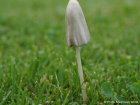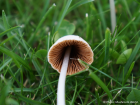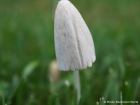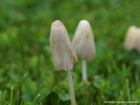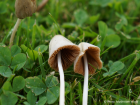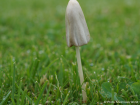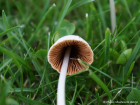Cap pale cream to silvery-white colour and may sometimes have a darker yellow to brown colouration towards the central umbo. Its hood-shaped conical cap expands with age and may flatten out, the surface being marked by minute radiating ridges. Gills adnexed or free, rust-coloured or cinnamon brown and quite dense. The gills may be visible through the thin cap. Stem coloured as the cap, elongated, thin, hollow and more or less equal along its length. The stem has no ring and is extremely fragile. Spore print rust-brown.
Microscopic Features: Spores are ellipsoidal, measuring 11-14μm in length and 6.5-9μm in width. They have thick walls and a broad apical germ pore.
Conocybe apala on the First Nature Web site.
Conocybe apala on the MushroomExpert.Com Web site.
Many mushrooms are poisonous, and some can be lethally toxic. Distinguishing between edible and poisonous mushrooms can be very challenging. Therefore, we strongly advise against consuming wild mushrooms. This website does not contain any information about the edibility or toxicity of mushrooms.
Although efforts have been made to ensure accuracy on this website, the information may contain errors and omissions. Therefore, all content provided is for educational and informational purposes only and should not be relied upon or used as a basis for consuming any plants or mushrooms.
External links are provided for reference only. We do not endorse or take responsibility for the content, advice, or products found on these sites or in any advertisements shown on this website.
